A Deep Dive into Van Gogh's 'The Starry Night': Visual Analysis
VerifiedAdded on 2023/06/04
|9
|2487
|433
Essay
AI Summary
This essay provides a detailed visual analysis of Vincent van Gogh's 'The Starry Night,' created during his time at the St. Remy Hospital. It explores the painting's style, symbolism, and use of color, highlighting Van Gogh's unique perspective and emotional expression. The analysis considers the historical context, including the shift from Impressionism to Post-Impressionism, and examines the accuracy of the depiction in relation to Van Gogh's actual view from his window. The essay also discusses the painting techniques, such as impasto, and various interpretations of the artwork, including themes of hope, life, and death. It references the artist's personal struggles and his fascination with the night sky, concluding with the painting's journey after his death and its enduring universal appeal.
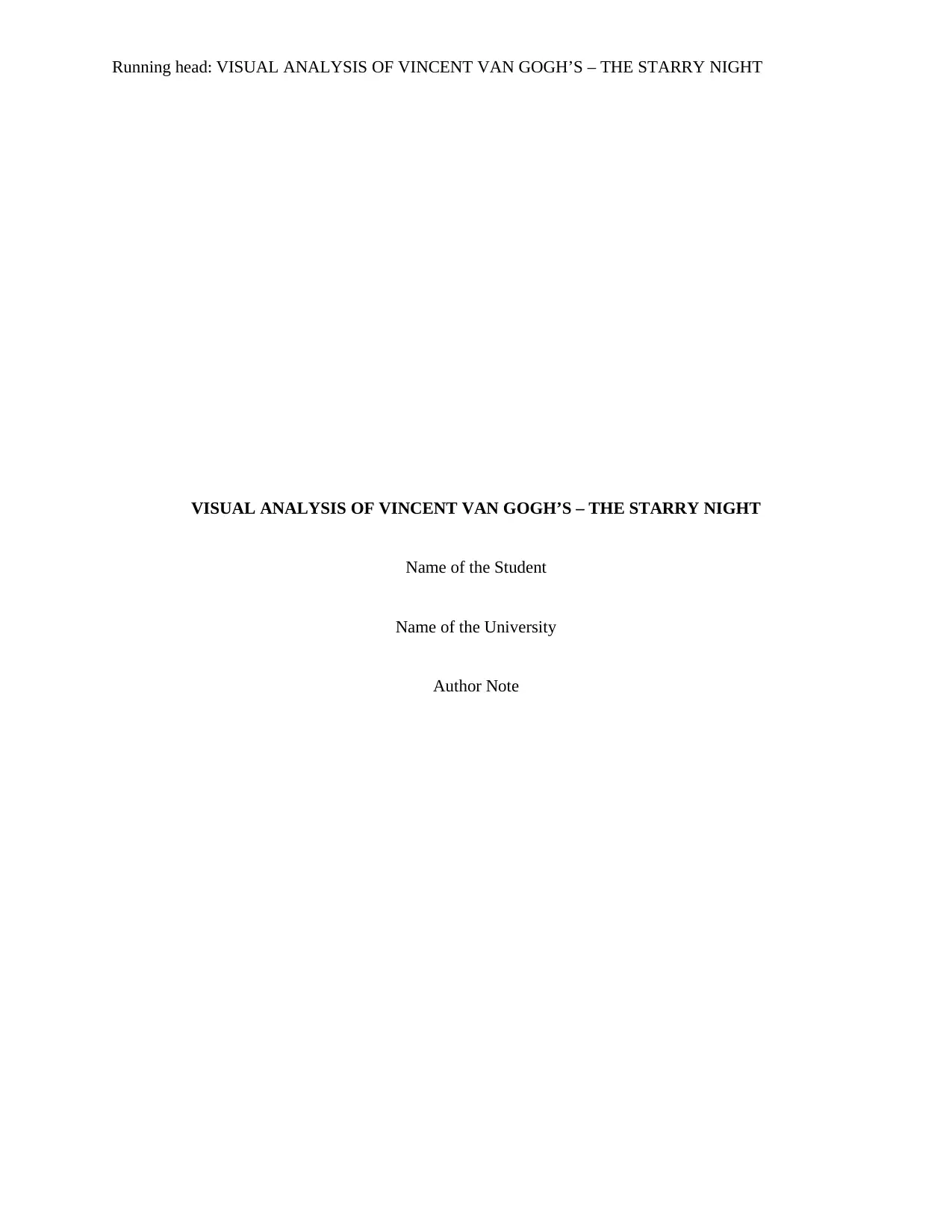
Running head: VISUAL ANALYSIS OF VINCENT VAN GOGH’S – THE STARRY NIGHT
VISUAL ANALYSIS OF VINCENT VAN GOGH’S – THE STARRY NIGHT
Name of the Student
Name of the University
Author Note
VISUAL ANALYSIS OF VINCENT VAN GOGH’S – THE STARRY NIGHT
Name of the Student
Name of the University
Author Note
Paraphrase This Document
Need a fresh take? Get an instant paraphrase of this document with our AI Paraphraser
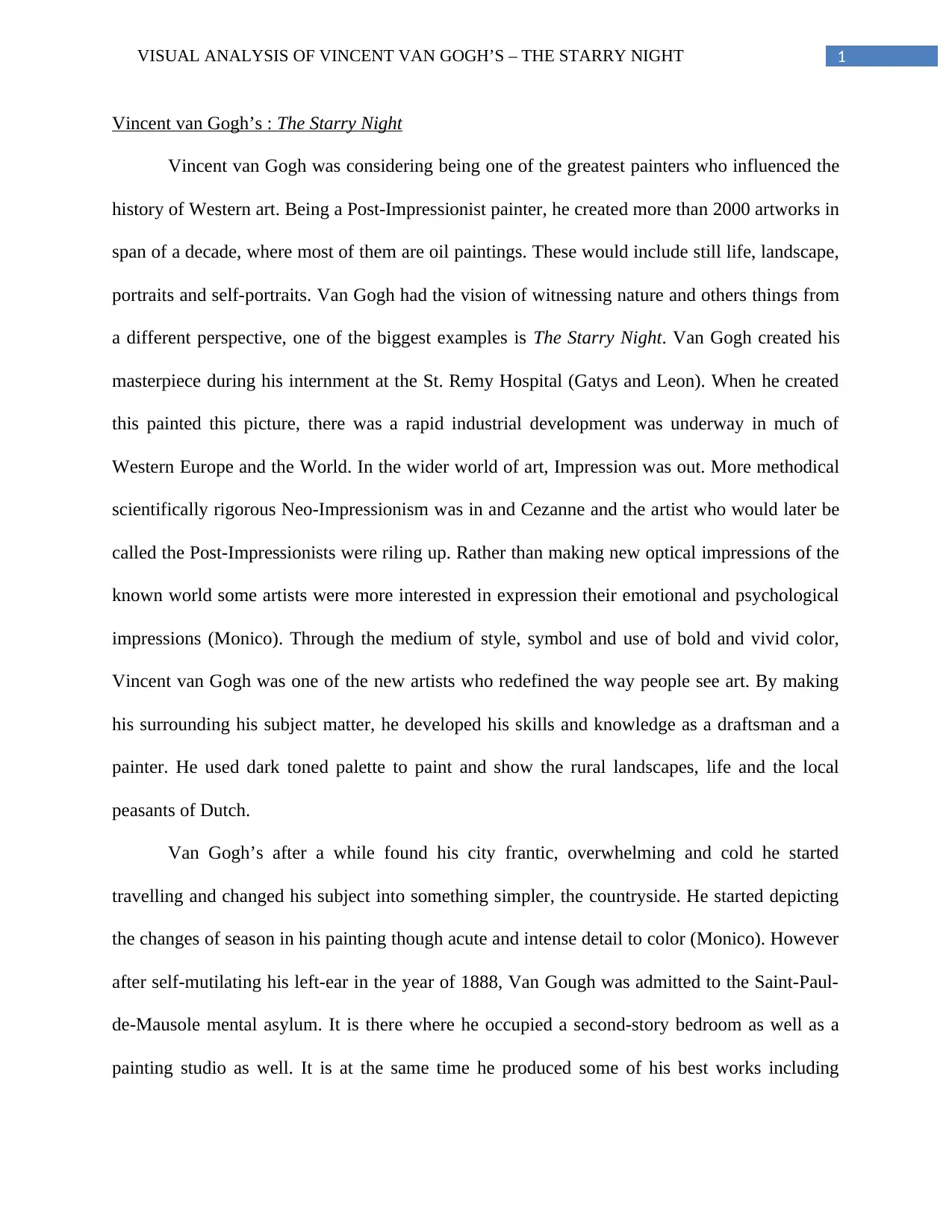
1VISUAL ANALYSIS OF VINCENT VAN GOGH’S – THE STARRY NIGHT
Vincent van Gogh’s : The Starry Night
Vincent van Gogh was considering being one of the greatest painters who influenced the
history of Western art. Being a Post-Impressionist painter, he created more than 2000 artworks in
span of a decade, where most of them are oil paintings. These would include still life, landscape,
portraits and self-portraits. Van Gogh had the vision of witnessing nature and others things from
a different perspective, one of the biggest examples is The Starry Night. Van Gogh created his
masterpiece during his internment at the St. Remy Hospital (Gatys and Leon). When he created
this painted this picture, there was a rapid industrial development was underway in much of
Western Europe and the World. In the wider world of art, Impression was out. More methodical
scientifically rigorous Neo-Impressionism was in and Cezanne and the artist who would later be
called the Post-Impressionists were riling up. Rather than making new optical impressions of the
known world some artists were more interested in expression their emotional and psychological
impressions (Monico). Through the medium of style, symbol and use of bold and vivid color,
Vincent van Gogh was one of the new artists who redefined the way people see art. By making
his surrounding his subject matter, he developed his skills and knowledge as a draftsman and a
painter. He used dark toned palette to paint and show the rural landscapes, life and the local
peasants of Dutch.
Van Gogh’s after a while found his city frantic, overwhelming and cold he started
travelling and changed his subject into something simpler, the countryside. He started depicting
the changes of season in his painting though acute and intense detail to color (Monico). However
after self-mutilating his left-ear in the year of 1888, Van Gough was admitted to the Saint-Paul-
de-Mausole mental asylum. It is there where he occupied a second-story bedroom as well as a
painting studio as well. It is at the same time he produced some of his best works including
Vincent van Gogh’s : The Starry Night
Vincent van Gogh was considering being one of the greatest painters who influenced the
history of Western art. Being a Post-Impressionist painter, he created more than 2000 artworks in
span of a decade, where most of them are oil paintings. These would include still life, landscape,
portraits and self-portraits. Van Gogh had the vision of witnessing nature and others things from
a different perspective, one of the biggest examples is The Starry Night. Van Gogh created his
masterpiece during his internment at the St. Remy Hospital (Gatys and Leon). When he created
this painted this picture, there was a rapid industrial development was underway in much of
Western Europe and the World. In the wider world of art, Impression was out. More methodical
scientifically rigorous Neo-Impressionism was in and Cezanne and the artist who would later be
called the Post-Impressionists were riling up. Rather than making new optical impressions of the
known world some artists were more interested in expression their emotional and psychological
impressions (Monico). Through the medium of style, symbol and use of bold and vivid color,
Vincent van Gogh was one of the new artists who redefined the way people see art. By making
his surrounding his subject matter, he developed his skills and knowledge as a draftsman and a
painter. He used dark toned palette to paint and show the rural landscapes, life and the local
peasants of Dutch.
Van Gogh’s after a while found his city frantic, overwhelming and cold he started
travelling and changed his subject into something simpler, the countryside. He started depicting
the changes of season in his painting though acute and intense detail to color (Monico). However
after self-mutilating his left-ear in the year of 1888, Van Gough was admitted to the Saint-Paul-
de-Mausole mental asylum. It is there where he occupied a second-story bedroom as well as a
painting studio as well. It is at the same time he produced some of his best works including
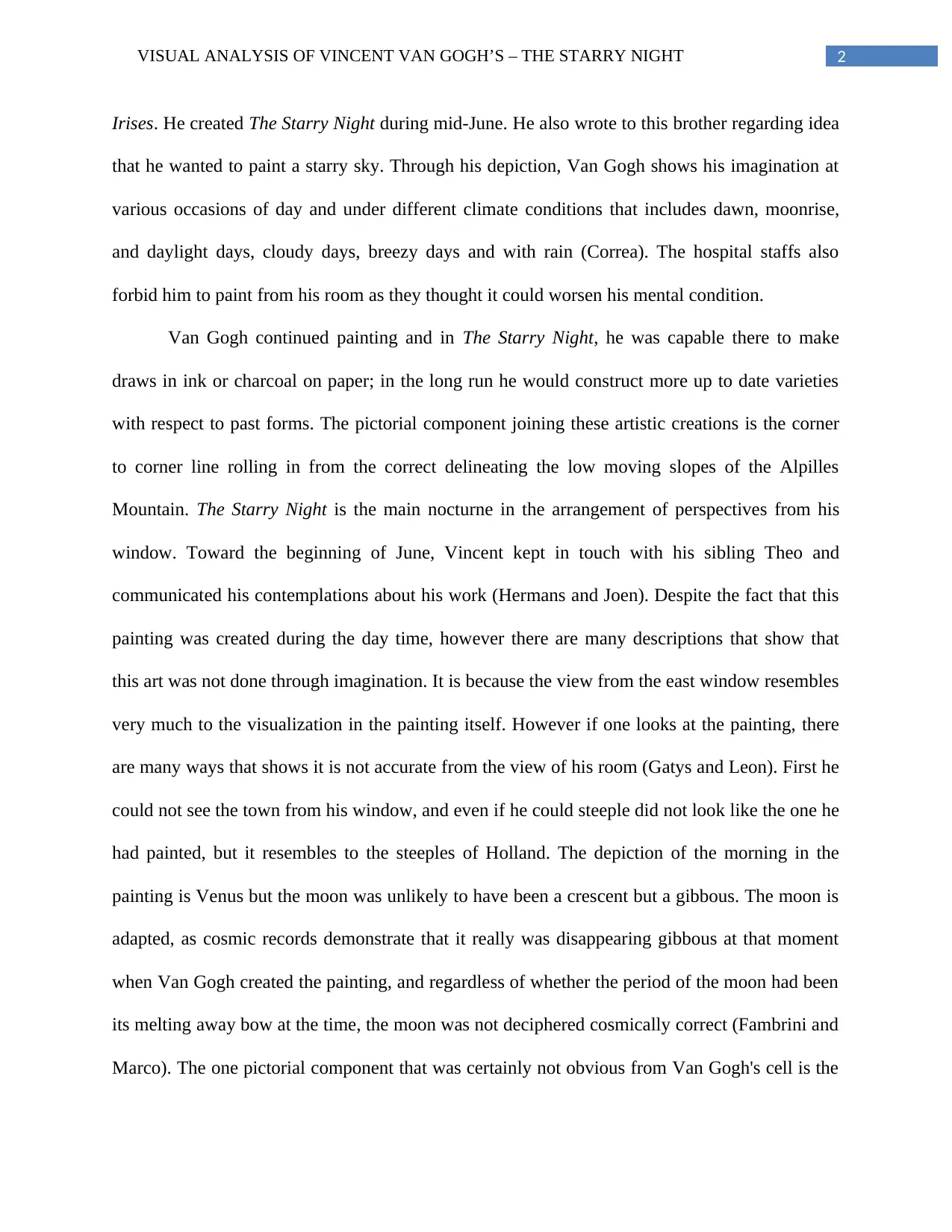
2VISUAL ANALYSIS OF VINCENT VAN GOGH’S – THE STARRY NIGHT
Irises. He created The Starry Night during mid-June. He also wrote to this brother regarding idea
that he wanted to paint a starry sky. Through his depiction, Van Gogh shows his imagination at
various occasions of day and under different climate conditions that includes dawn, moonrise,
and daylight days, cloudy days, breezy days and with rain (Correa). The hospital staffs also
forbid him to paint from his room as they thought it could worsen his mental condition.
Van Gogh continued painting and in The Starry Night, he was capable there to make
draws in ink or charcoal on paper; in the long run he would construct more up to date varieties
with respect to past forms. The pictorial component joining these artistic creations is the corner
to corner line rolling in from the correct delineating the low moving slopes of the Alpilles
Mountain. The Starry Night is the main nocturne in the arrangement of perspectives from his
window. Toward the beginning of June, Vincent kept in touch with his sibling Theo and
communicated his contemplations about his work (Hermans and Joen). Despite the fact that this
painting was created during the day time, however there are many descriptions that show that
this art was not done through imagination. It is because the view from the east window resembles
very much to the visualization in the painting itself. However if one looks at the painting, there
are many ways that shows it is not accurate from the view of his room (Gatys and Leon). First he
could not see the town from his window, and even if he could steeple did not look like the one he
had painted, but it resembles to the steeples of Holland. The depiction of the morning in the
painting is Venus but the moon was unlikely to have been a crescent but a gibbous. The moon is
adapted, as cosmic records demonstrate that it really was disappearing gibbous at that moment
when Van Gogh created the painting, and regardless of whether the period of the moon had been
its melting away bow at the time, the moon was not deciphered cosmically correct (Fambrini and
Marco). The one pictorial component that was certainly not obvious from Van Gogh's cell is the
Irises. He created The Starry Night during mid-June. He also wrote to this brother regarding idea
that he wanted to paint a starry sky. Through his depiction, Van Gogh shows his imagination at
various occasions of day and under different climate conditions that includes dawn, moonrise,
and daylight days, cloudy days, breezy days and with rain (Correa). The hospital staffs also
forbid him to paint from his room as they thought it could worsen his mental condition.
Van Gogh continued painting and in The Starry Night, he was capable there to make
draws in ink or charcoal on paper; in the long run he would construct more up to date varieties
with respect to past forms. The pictorial component joining these artistic creations is the corner
to corner line rolling in from the correct delineating the low moving slopes of the Alpilles
Mountain. The Starry Night is the main nocturne in the arrangement of perspectives from his
window. Toward the beginning of June, Vincent kept in touch with his sibling Theo and
communicated his contemplations about his work (Hermans and Joen). Despite the fact that this
painting was created during the day time, however there are many descriptions that show that
this art was not done through imagination. It is because the view from the east window resembles
very much to the visualization in the painting itself. However if one looks at the painting, there
are many ways that shows it is not accurate from the view of his room (Gatys and Leon). First he
could not see the town from his window, and even if he could steeple did not look like the one he
had painted, but it resembles to the steeples of Holland. The depiction of the morning in the
painting is Venus but the moon was unlikely to have been a crescent but a gibbous. The moon is
adapted, as cosmic records demonstrate that it really was disappearing gibbous at that moment
when Van Gogh created the painting, and regardless of whether the period of the moon had been
its melting away bow at the time, the moon was not deciphered cosmically correct (Fambrini and
Marco). The one pictorial component that was certainly not obvious from Van Gogh's cell is the
⊘ This is a preview!⊘
Do you want full access?
Subscribe today to unlock all pages.

Trusted by 1+ million students worldwide
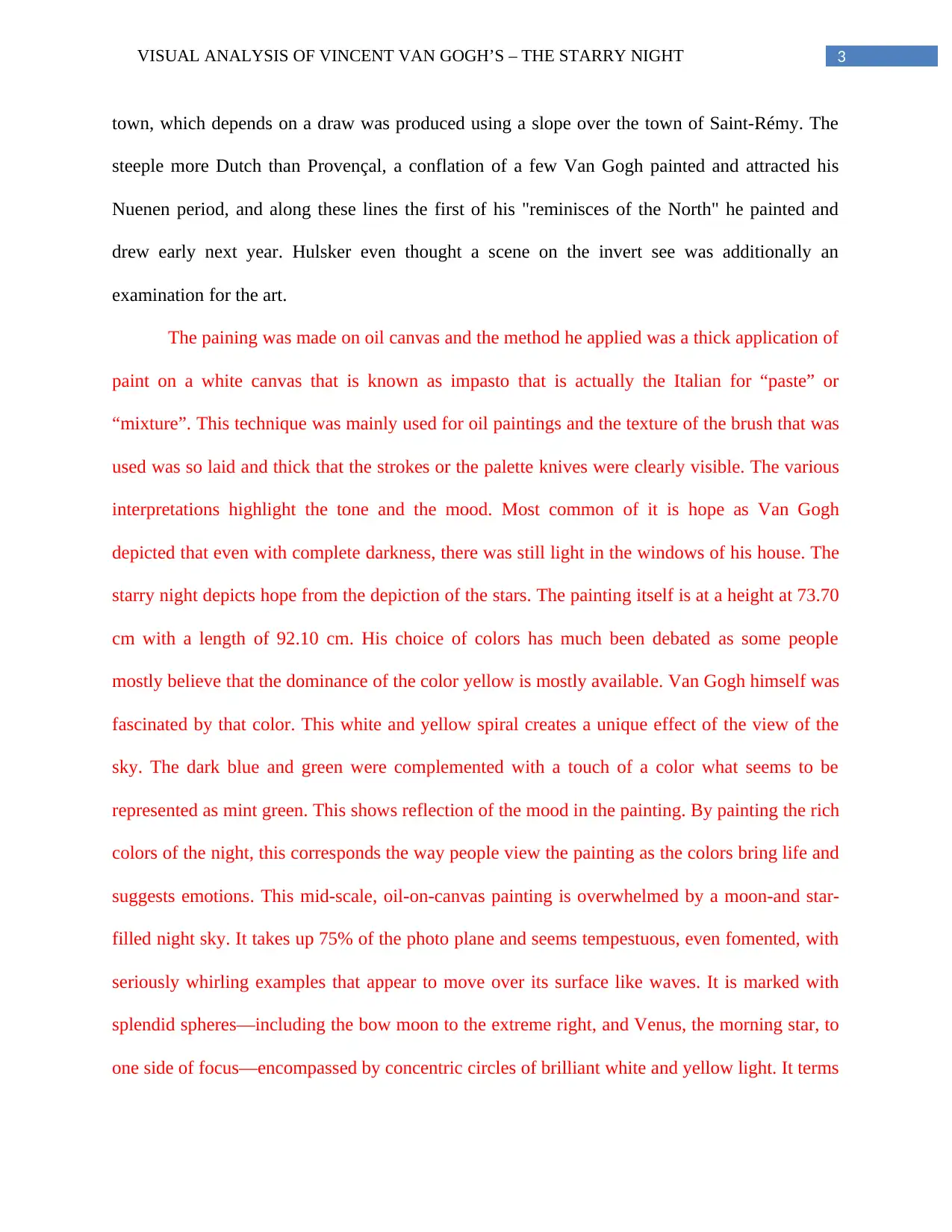
3VISUAL ANALYSIS OF VINCENT VAN GOGH’S – THE STARRY NIGHT
town, which depends on a draw was produced using a slope over the town of Saint-Rémy. The
steeple more Dutch than Provençal, a conflation of a few Van Gogh painted and attracted his
Nuenen period, and along these lines the first of his "reminisces of the North" he painted and
drew early next year. Hulsker even thought a scene on the invert see was additionally an
examination for the art.
The paining was made on oil canvas and the method he applied was a thick application of
paint on a white canvas that is known as impasto that is actually the Italian for “paste” or
“mixture”. This technique was mainly used for oil paintings and the texture of the brush that was
used was so laid and thick that the strokes or the palette knives were clearly visible. The various
interpretations highlight the tone and the mood. Most common of it is hope as Van Gogh
depicted that even with complete darkness, there was still light in the windows of his house. The
starry night depicts hope from the depiction of the stars. The painting itself is at a height at 73.70
cm with a length of 92.10 cm. His choice of colors has much been debated as some people
mostly believe that the dominance of the color yellow is mostly available. Van Gogh himself was
fascinated by that color. This white and yellow spiral creates a unique effect of the view of the
sky. The dark blue and green were complemented with a touch of a color what seems to be
represented as mint green. This shows reflection of the mood in the painting. By painting the rich
colors of the night, this corresponds the way people view the painting as the colors bring life and
suggests emotions. This mid-scale, oil-on-canvas painting is overwhelmed by a moon-and star-
filled night sky. It takes up 75% of the photo plane and seems tempestuous, even fomented, with
seriously whirling examples that appear to move over its surface like waves. It is marked with
splendid spheres—including the bow moon to the extreme right, and Venus, the morning star, to
one side of focus—encompassed by concentric circles of brilliant white and yellow light. It terms
town, which depends on a draw was produced using a slope over the town of Saint-Rémy. The
steeple more Dutch than Provençal, a conflation of a few Van Gogh painted and attracted his
Nuenen period, and along these lines the first of his "reminisces of the North" he painted and
drew early next year. Hulsker even thought a scene on the invert see was additionally an
examination for the art.
The paining was made on oil canvas and the method he applied was a thick application of
paint on a white canvas that is known as impasto that is actually the Italian for “paste” or
“mixture”. This technique was mainly used for oil paintings and the texture of the brush that was
used was so laid and thick that the strokes or the palette knives were clearly visible. The various
interpretations highlight the tone and the mood. Most common of it is hope as Van Gogh
depicted that even with complete darkness, there was still light in the windows of his house. The
starry night depicts hope from the depiction of the stars. The painting itself is at a height at 73.70
cm with a length of 92.10 cm. His choice of colors has much been debated as some people
mostly believe that the dominance of the color yellow is mostly available. Van Gogh himself was
fascinated by that color. This white and yellow spiral creates a unique effect of the view of the
sky. The dark blue and green were complemented with a touch of a color what seems to be
represented as mint green. This shows reflection of the mood in the painting. By painting the rich
colors of the night, this corresponds the way people view the painting as the colors bring life and
suggests emotions. This mid-scale, oil-on-canvas painting is overwhelmed by a moon-and star-
filled night sky. It takes up 75% of the photo plane and seems tempestuous, even fomented, with
seriously whirling examples that appear to move over its surface like waves. It is marked with
splendid spheres—including the bow moon to the extreme right, and Venus, the morning star, to
one side of focus—encompassed by concentric circles of brilliant white and yellow light. It terms
Paraphrase This Document
Need a fresh take? Get an instant paraphrase of this document with our AI Paraphraser
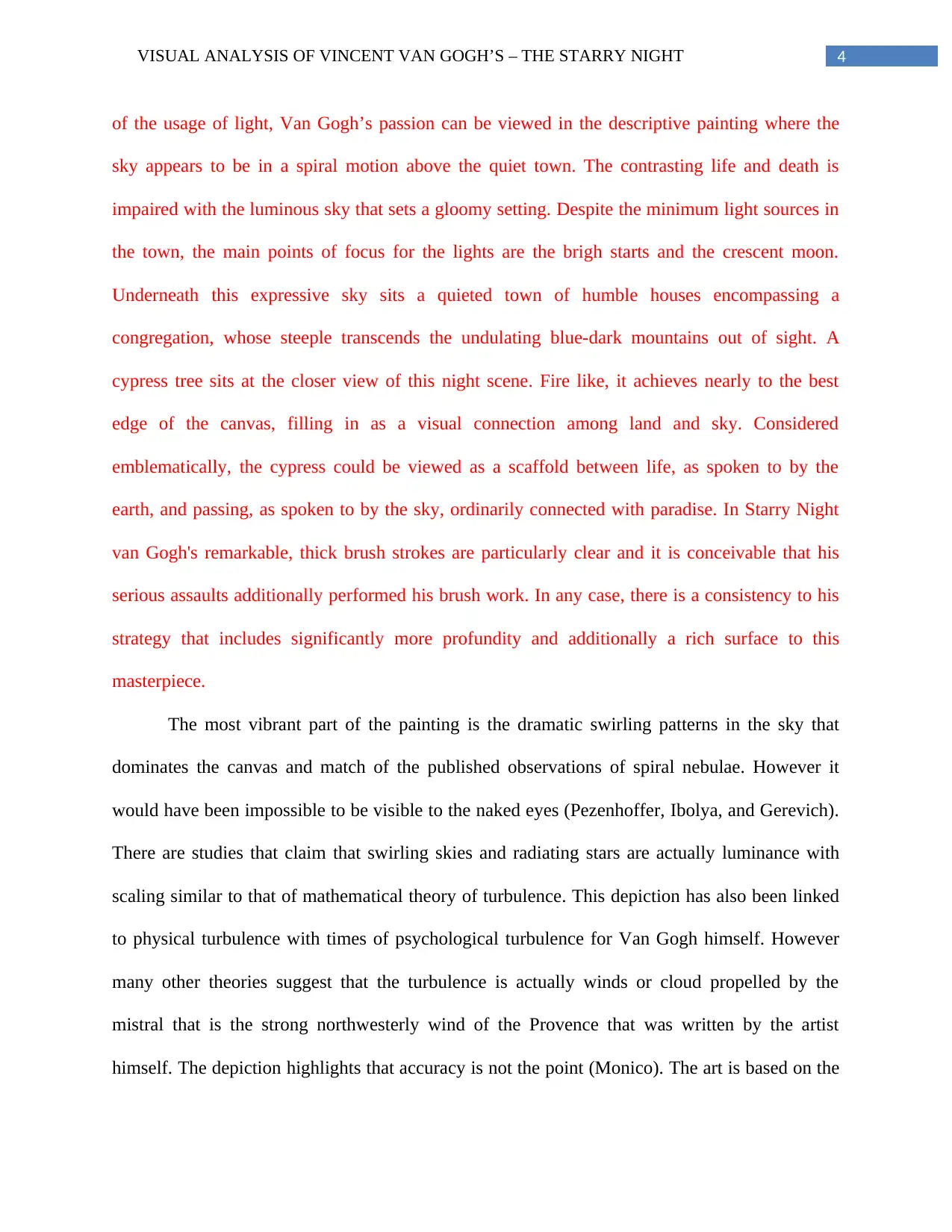
4VISUAL ANALYSIS OF VINCENT VAN GOGH’S – THE STARRY NIGHT
of the usage of light, Van Gogh’s passion can be viewed in the descriptive painting where the
sky appears to be in a spiral motion above the quiet town. The contrasting life and death is
impaired with the luminous sky that sets a gloomy setting. Despite the minimum light sources in
the town, the main points of focus for the lights are the brigh starts and the crescent moon.
Underneath this expressive sky sits a quieted town of humble houses encompassing a
congregation, whose steeple transcends the undulating blue-dark mountains out of sight. A
cypress tree sits at the closer view of this night scene. Fire like, it achieves nearly to the best
edge of the canvas, filling in as a visual connection among land and sky. Considered
emblematically, the cypress could be viewed as a scaffold between life, as spoken to by the
earth, and passing, as spoken to by the sky, ordinarily connected with paradise. In Starry Night
van Gogh's remarkable, thick brush strokes are particularly clear and it is conceivable that his
serious assaults additionally performed his brush work. In any case, there is a consistency to his
strategy that includes significantly more profundity and additionally a rich surface to this
masterpiece.
The most vibrant part of the painting is the dramatic swirling patterns in the sky that
dominates the canvas and match of the published observations of spiral nebulae. However it
would have been impossible to be visible to the naked eyes (Pezenhoffer, Ibolya, and Gerevich).
There are studies that claim that swirling skies and radiating stars are actually luminance with
scaling similar to that of mathematical theory of turbulence. This depiction has also been linked
to physical turbulence with times of psychological turbulence for Van Gogh himself. However
many other theories suggest that the turbulence is actually winds or cloud propelled by the
mistral that is the strong northwesterly wind of the Provence that was written by the artist
himself. The depiction highlights that accuracy is not the point (Monico). The art is based on the
of the usage of light, Van Gogh’s passion can be viewed in the descriptive painting where the
sky appears to be in a spiral motion above the quiet town. The contrasting life and death is
impaired with the luminous sky that sets a gloomy setting. Despite the minimum light sources in
the town, the main points of focus for the lights are the brigh starts and the crescent moon.
Underneath this expressive sky sits a quieted town of humble houses encompassing a
congregation, whose steeple transcends the undulating blue-dark mountains out of sight. A
cypress tree sits at the closer view of this night scene. Fire like, it achieves nearly to the best
edge of the canvas, filling in as a visual connection among land and sky. Considered
emblematically, the cypress could be viewed as a scaffold between life, as spoken to by the
earth, and passing, as spoken to by the sky, ordinarily connected with paradise. In Starry Night
van Gogh's remarkable, thick brush strokes are particularly clear and it is conceivable that his
serious assaults additionally performed his brush work. In any case, there is a consistency to his
strategy that includes significantly more profundity and additionally a rich surface to this
masterpiece.
The most vibrant part of the painting is the dramatic swirling patterns in the sky that
dominates the canvas and match of the published observations of spiral nebulae. However it
would have been impossible to be visible to the naked eyes (Pezenhoffer, Ibolya, and Gerevich).
There are studies that claim that swirling skies and radiating stars are actually luminance with
scaling similar to that of mathematical theory of turbulence. This depiction has also been linked
to physical turbulence with times of psychological turbulence for Van Gogh himself. However
many other theories suggest that the turbulence is actually winds or cloud propelled by the
mistral that is the strong northwesterly wind of the Provence that was written by the artist
himself. The depiction highlights that accuracy is not the point (Monico). The art is based on the
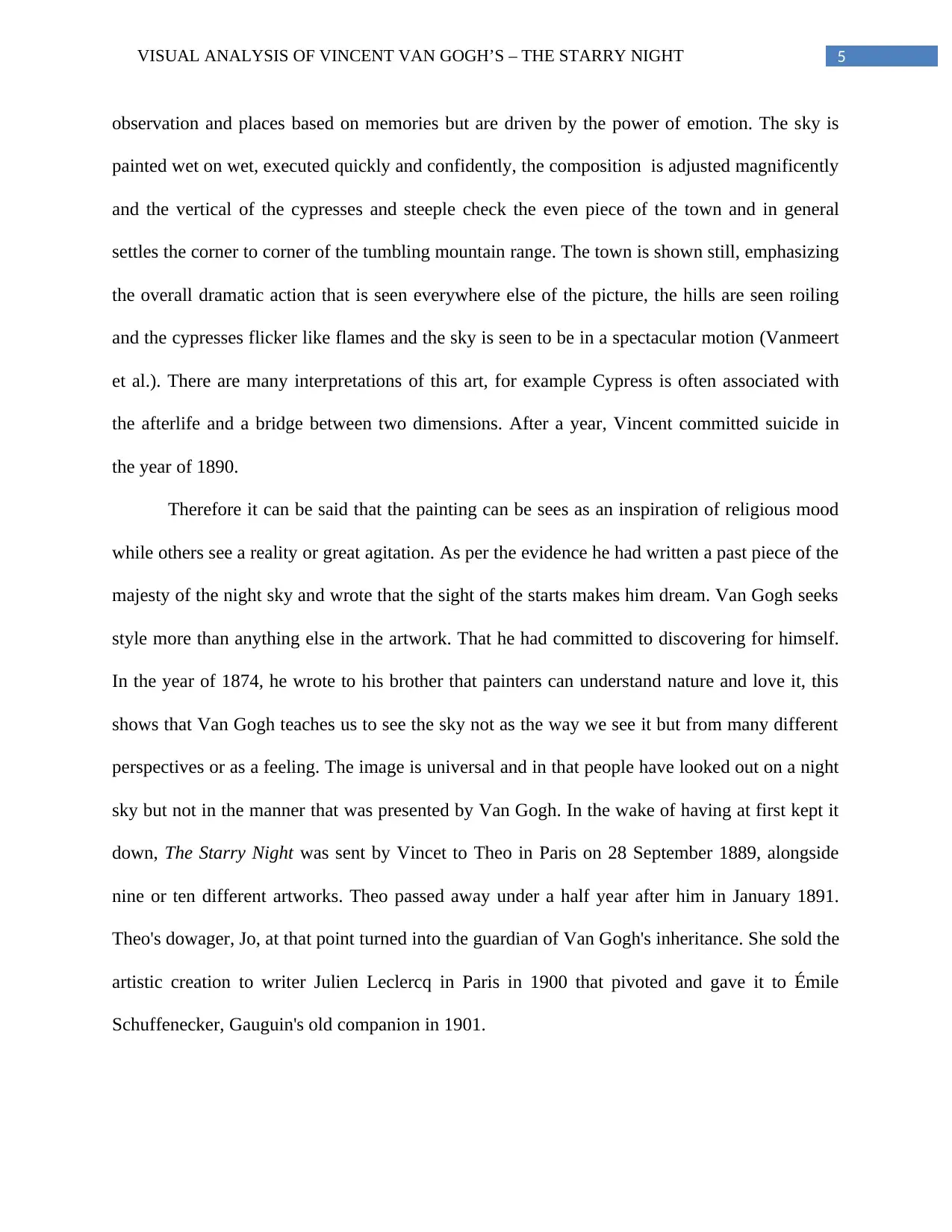
5VISUAL ANALYSIS OF VINCENT VAN GOGH’S – THE STARRY NIGHT
observation and places based on memories but are driven by the power of emotion. The sky is
painted wet on wet, executed quickly and confidently, the composition is adjusted magnificently
and the vertical of the cypresses and steeple check the even piece of the town and in general
settles the corner to corner of the tumbling mountain range. The town is shown still, emphasizing
the overall dramatic action that is seen everywhere else of the picture, the hills are seen roiling
and the cypresses flicker like flames and the sky is seen to be in a spectacular motion (Vanmeert
et al.). There are many interpretations of this art, for example Cypress is often associated with
the afterlife and a bridge between two dimensions. After a year, Vincent committed suicide in
the year of 1890.
Therefore it can be said that the painting can be sees as an inspiration of religious mood
while others see a reality or great agitation. As per the evidence he had written a past piece of the
majesty of the night sky and wrote that the sight of the starts makes him dream. Van Gogh seeks
style more than anything else in the artwork. That he had committed to discovering for himself.
In the year of 1874, he wrote to his brother that painters can understand nature and love it, this
shows that Van Gogh teaches us to see the sky not as the way we see it but from many different
perspectives or as a feeling. The image is universal and in that people have looked out on a night
sky but not in the manner that was presented by Van Gogh. In the wake of having at first kept it
down, The Starry Night was sent by Vincet to Theo in Paris on 28 September 1889, alongside
nine or ten different artworks. Theo passed away under a half year after him in January 1891.
Theo's dowager, Jo, at that point turned into the guardian of Van Gogh's inheritance. She sold the
artistic creation to writer Julien Leclercq in Paris in 1900 that pivoted and gave it to Émile
Schuffenecker, Gauguin's old companion in 1901.
observation and places based on memories but are driven by the power of emotion. The sky is
painted wet on wet, executed quickly and confidently, the composition is adjusted magnificently
and the vertical of the cypresses and steeple check the even piece of the town and in general
settles the corner to corner of the tumbling mountain range. The town is shown still, emphasizing
the overall dramatic action that is seen everywhere else of the picture, the hills are seen roiling
and the cypresses flicker like flames and the sky is seen to be in a spectacular motion (Vanmeert
et al.). There are many interpretations of this art, for example Cypress is often associated with
the afterlife and a bridge between two dimensions. After a year, Vincent committed suicide in
the year of 1890.
Therefore it can be said that the painting can be sees as an inspiration of religious mood
while others see a reality or great agitation. As per the evidence he had written a past piece of the
majesty of the night sky and wrote that the sight of the starts makes him dream. Van Gogh seeks
style more than anything else in the artwork. That he had committed to discovering for himself.
In the year of 1874, he wrote to his brother that painters can understand nature and love it, this
shows that Van Gogh teaches us to see the sky not as the way we see it but from many different
perspectives or as a feeling. The image is universal and in that people have looked out on a night
sky but not in the manner that was presented by Van Gogh. In the wake of having at first kept it
down, The Starry Night was sent by Vincet to Theo in Paris on 28 September 1889, alongside
nine or ten different artworks. Theo passed away under a half year after him in January 1891.
Theo's dowager, Jo, at that point turned into the guardian of Van Gogh's inheritance. She sold the
artistic creation to writer Julien Leclercq in Paris in 1900 that pivoted and gave it to Émile
Schuffenecker, Gauguin's old companion in 1901.
⊘ This is a preview!⊘
Do you want full access?
Subscribe today to unlock all pages.

Trusted by 1+ million students worldwide
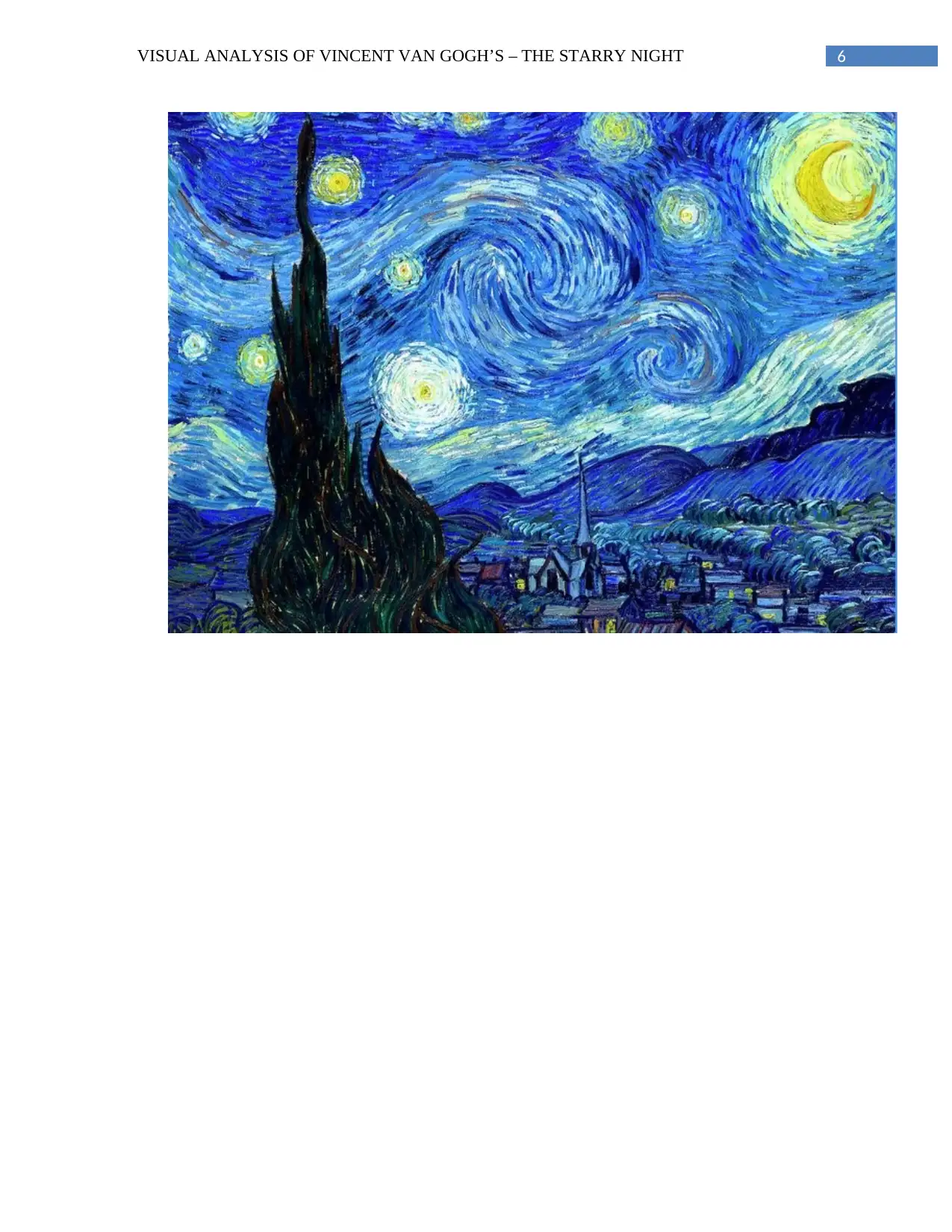
6VISUAL ANALYSIS OF VINCENT VAN GOGH’S – THE STARRY NIGHT
Paraphrase This Document
Need a fresh take? Get an instant paraphrase of this document with our AI Paraphraser
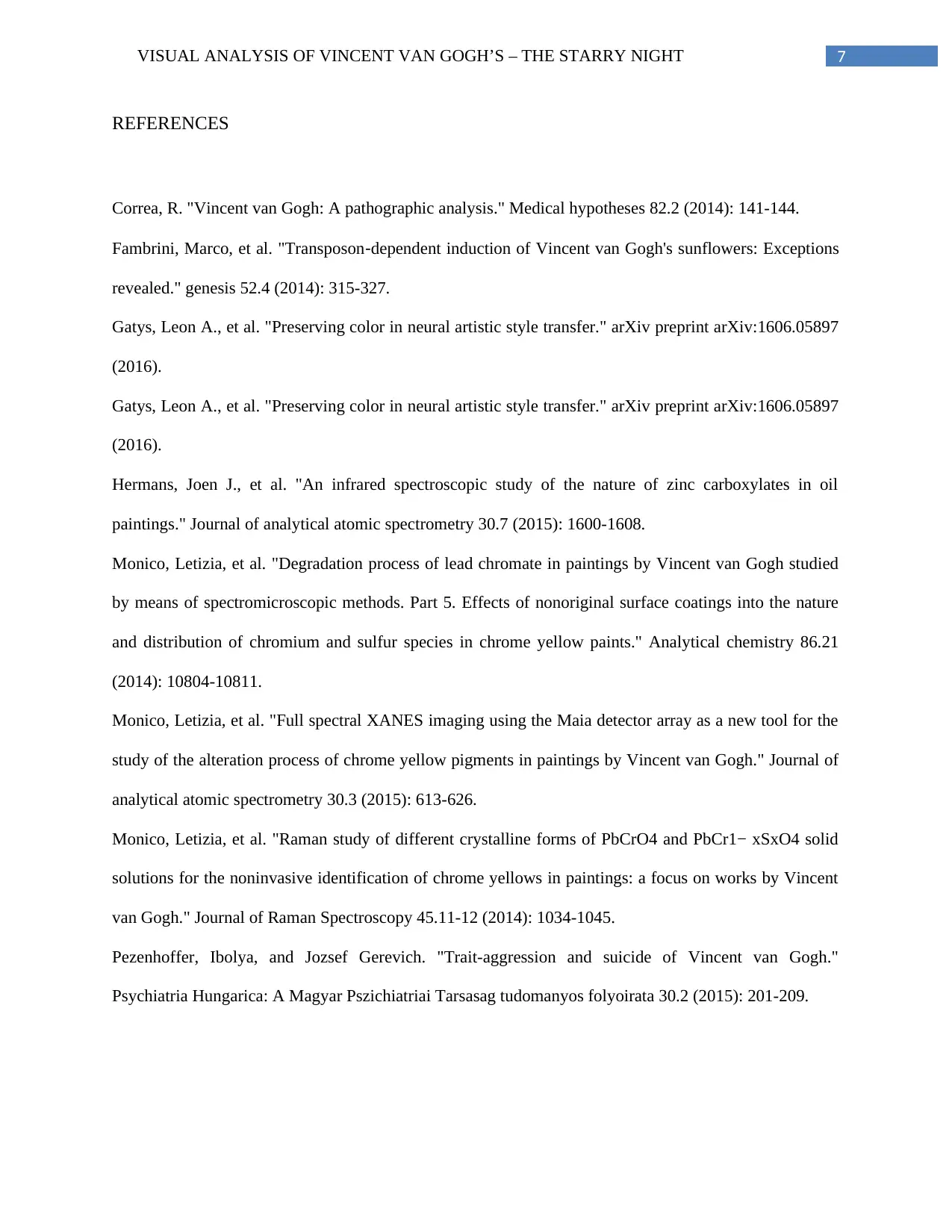
7VISUAL ANALYSIS OF VINCENT VAN GOGH’S – THE STARRY NIGHT
REFERENCES
Correa, R. "Vincent van Gogh: A pathographic analysis." Medical hypotheses 82.2 (2014): 141-144.
Fambrini, Marco, et al. "Transposon‐dependent induction of Vincent van Gogh's sunflowers: Exceptions
revealed." genesis 52.4 (2014): 315-327.
Gatys, Leon A., et al. "Preserving color in neural artistic style transfer." arXiv preprint arXiv:1606.05897
(2016).
Gatys, Leon A., et al. "Preserving color in neural artistic style transfer." arXiv preprint arXiv:1606.05897
(2016).
Hermans, Joen J., et al. "An infrared spectroscopic study of the nature of zinc carboxylates in oil
paintings." Journal of analytical atomic spectrometry 30.7 (2015): 1600-1608.
Monico, Letizia, et al. "Degradation process of lead chromate in paintings by Vincent van Gogh studied
by means of spectromicroscopic methods. Part 5. Effects of nonoriginal surface coatings into the nature
and distribution of chromium and sulfur species in chrome yellow paints." Analytical chemistry 86.21
(2014): 10804-10811.
Monico, Letizia, et al. "Full spectral XANES imaging using the Maia detector array as a new tool for the
study of the alteration process of chrome yellow pigments in paintings by Vincent van Gogh." Journal of
analytical atomic spectrometry 30.3 (2015): 613-626.
Monico, Letizia, et al. "Raman study of different crystalline forms of PbCrO4 and PbCr1− xSxO4 solid
solutions for the noninvasive identification of chrome yellows in paintings: a focus on works by Vincent
van Gogh." Journal of Raman Spectroscopy 45.11-12 (2014): 1034-1045.
Pezenhoffer, Ibolya, and Jozsef Gerevich. "Trait-aggression and suicide of Vincent van Gogh."
Psychiatria Hungarica: A Magyar Pszichiatriai Tarsasag tudomanyos folyoirata 30.2 (2015): 201-209.
REFERENCES
Correa, R. "Vincent van Gogh: A pathographic analysis." Medical hypotheses 82.2 (2014): 141-144.
Fambrini, Marco, et al. "Transposon‐dependent induction of Vincent van Gogh's sunflowers: Exceptions
revealed." genesis 52.4 (2014): 315-327.
Gatys, Leon A., et al. "Preserving color in neural artistic style transfer." arXiv preprint arXiv:1606.05897
(2016).
Gatys, Leon A., et al. "Preserving color in neural artistic style transfer." arXiv preprint arXiv:1606.05897
(2016).
Hermans, Joen J., et al. "An infrared spectroscopic study of the nature of zinc carboxylates in oil
paintings." Journal of analytical atomic spectrometry 30.7 (2015): 1600-1608.
Monico, Letizia, et al. "Degradation process of lead chromate in paintings by Vincent van Gogh studied
by means of spectromicroscopic methods. Part 5. Effects of nonoriginal surface coatings into the nature
and distribution of chromium and sulfur species in chrome yellow paints." Analytical chemistry 86.21
(2014): 10804-10811.
Monico, Letizia, et al. "Full spectral XANES imaging using the Maia detector array as a new tool for the
study of the alteration process of chrome yellow pigments in paintings by Vincent van Gogh." Journal of
analytical atomic spectrometry 30.3 (2015): 613-626.
Monico, Letizia, et al. "Raman study of different crystalline forms of PbCrO4 and PbCr1− xSxO4 solid
solutions for the noninvasive identification of chrome yellows in paintings: a focus on works by Vincent
van Gogh." Journal of Raman Spectroscopy 45.11-12 (2014): 1034-1045.
Pezenhoffer, Ibolya, and Jozsef Gerevich. "Trait-aggression and suicide of Vincent van Gogh."
Psychiatria Hungarica: A Magyar Pszichiatriai Tarsasag tudomanyos folyoirata 30.2 (2015): 201-209.

8VISUAL ANALYSIS OF VINCENT VAN GOGH’S – THE STARRY NIGHT
Vanmeert, Frederik, Geert Van der Snickt, and Koen Janssens. "Plumbonacrite identified by X‐ray
powder diffraction tomography as a missing link during degradation of red lead in a Van Gogh painting."
Angewandte Chemie International Edition 54.12 (2015): 3607-3610.
Vanmeert, Frederik, Geert Van der Snickt, and Koen Janssens. "Plumbonacrite identified by X‐ray
powder diffraction tomography as a missing link during degradation of red lead in a Van Gogh painting."
Angewandte Chemie International Edition 54.12 (2015): 3607-3610.
⊘ This is a preview!⊘
Do you want full access?
Subscribe today to unlock all pages.

Trusted by 1+ million students worldwide
1 out of 9
Related Documents
Your All-in-One AI-Powered Toolkit for Academic Success.
+13062052269
info@desklib.com
Available 24*7 on WhatsApp / Email
![[object Object]](/_next/static/media/star-bottom.7253800d.svg)
Unlock your academic potential
Copyright © 2020–2025 A2Z Services. All Rights Reserved. Developed and managed by ZUCOL.





